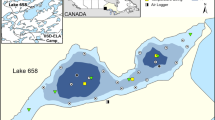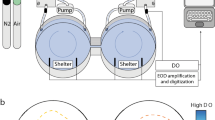Abstract
Many intertidal fishes, particularly among the Blenniidae and Cottidae, possess amphibious adaptations, including the ability to breathe in air and to avoid desiccation in terrestrial conditions. These traits are absent in subtidal species of blennies and cottids. Hypsoblennius gilberti, the rockpool blenny, is found in shallow rockpools in the mid to high intertidal areas of Southern California, and deeper to 18 m in the subtidal zone. This broad vertical distribution could indicate that this blenny is adapted for tidal air emergence, although H. gilberti has not been observed out of water in its natural habitat. H. gilberti does not emerge voluntarily from hypoxic sea water in the laboratory, but it easily withstands 3 h out of water. The aerial respiratory exchange ratio (CO2 released compared to O2 consumed) is 0.70, similar to that of amphibious intertidal fishes in air, indicating sufficient release of metabolically produced CO2 while emerged. There is no increase in aquatic respiration following emergence. However, unlike other amphibious fishes that maintain aerial oxygen consumption at a level similar to aquatic oxygen consumption, H. gilberti has an aerial oxygen consumption rate one-third that in water. H. gilberti can recover rapidly from terrestrial water loss, and shows no change in evaporative water loss rates at 93% and 77% relative humidities. The amphibious capabilities in H. gilberti, even if rarely used, permit survival in air during tidal emergence. These findings suggest that H. gilberti may demonstrate an intermediate condition between the amphibious species of intertidal fishes that regularly emerge from water, and the subtidal fishes that do not survive air emergence and are completely restricted to an aquatic habitat.
Similar content being viewed by others
References cited
Bartholomew, G.A. 1982. Energy metabolism. pp. 46–92. In: M.S. Gordon (ed.) Animal Physiology, Macmillan Publishing, New York.
Bartholomew, G.A., D. Vleck & C.M. Vleck. 1981. Instantaneous measurements of oxygen consumption during pre-flight warm-up and post-flight cooling in sphingid and saturnid moths. J. Exp. Biol. 90: 17–32.
Bennett, A.F. 1978. Activity metabolism of the lower vertebrates. Ann. Rev. Physiol. 400: 447–469.
Bridges, C.R. 1988. Respiratory adaptations in intertidal fish. Amer. Zool. 28: 79–96.
Bridges, C.R. 1993. Adaptations of vertebrates to the intertidal environment. pp. 12–22. In: J. Eduardo & P.W. Bicudo (ed.) The Vertebrate Gas Transport Cascade \3-Adaptations to Environment and Mode of Life, CRC Press, Boca Raton.
Bridges, C.R., A.C. Taylor, S.J. Morris & M.K. Grieshaber. 1984. Ecophysiological adaptations in Blennius pholis (L.) blood to intertidal rockpool environments. J. Exp. Mar. Biol. Ecol. 77: 151–167.
Brown, C.R., M.S. Gordon & K.L.M. Martin. 1992. Aerial and aquatic oxygen uptake in the amphibious Red Sea rockskipper fish, Alticus kirki (family Blenniidae). Copeia 1992: 1007–1013.
Davenport, J. & A.D. Woolmington. 1981. Behavioural responses of some rocky shore fish exposed to adverse environmental conditions. Mar. Behav. Physiol. 8: 1–12.
Daxboeck, C. & T.A. Heming. 1982. Bimodal respiration in the intertidal fish, Xiphister atropurpureus (Kittlitz). Mar. Behav. Physiol. 9: 23–33.
Eschmeyer, W.N. & E.S. Herald. 1983. A field guide to Pacific coast fishes, Houghton Mifflin Co., Boston. 336 pp.
Fitch, J.E. & R.J. Lavenberg. 1975. Tidepool and nearshore fishes of California. California Natural History Guides 38, University of California Press, Berkeley. 176 pp.
Gibson, R.N. 1982. Recent studies on the biology of intertidal fishes. Oceanogr. Mar. Biol. Ann. Rev. 20: 363–414.
Graham, J.B. 1973. Terrestrial life of the amphibious fish Mnierpes macrocephalus. Marine Biology 23: 83–91.
Graham, J.B. 1976. Respiratory adaptations of marine air-breathing fishes. pp. 165–187. In: G.M. Hughes (ed.) Respiration of Amphibious Vertebrates, Academic Press, London.
Graham, J.B. 1997. Air-breathing fishes. Academic Press, San Diego. 299 pp.
Graham, J.B., C.B. Jones & I. Rubinoff. 1985. Behavioural, physiological, and ecological aspects of the amphibious life of the pearl blenny Entomacrodus nigricans Gill. J. Exp. Mar. Biol. Ecol. 89: 255–268.
Hill, J.V., W. Davison & I.D. Marsden. 1996. Aspects of the respiratory biology of two New Zealand intertidal fishes, Acanthoclinus fuscus and Forsterygion sp. Env. Biol. Fish. 45: 85–93.
Horn, M.H. & K.C. Riegle. 1981. Evaporative water loss and intertidal vertical distribution in relation to body size and morphology of stichaeoid fishes from California. J. Exp. Mar. Biol. Ecol. 50: 273–288.
Louisy, P. 1987. Observations sur l'emersion nocturne de deux blennies Mediterraneennes: Coryphoblennius galerita et Blennius trigloides (Pisces, Perciformes). Cybium 11: 55–73.
Martin, K.L.M. 1991. Facultative aerial respiration in an intertidal sculpin, Clinocottus analis (Scorpaeniformes: Cottidae). Physiol. Zool. 64: 1341–1355.
Martin, K.L.M. 1993. Aerial release of CO2 and respiratory exchange ratio in intertidal fishes out of water. Env. Biol. Fish. 37: 189–196.
Martin, K.L.M. 1995. Time and tide wait for no fish: intertidal fishes out of water. Env. Biol. Fish. 44: 165–181.
Martin, K.L.M. 1996. An ecological gradient in air-breathing ability among marine cottid fishes. Physiol. Zool. 69: 1096–1113.
Martin, K.L.M. & J.R.B. Lighton. 1989. Aerial CO2 and O2 exchange during terrestrial activity in an amphibious fish, Alticus kirki (Blenniidae). Copeia 1989: 723–727.
Nieder, J. & C.D. Zander. 1994. Nocturnal activity of a blenny Lipophrys trigloides (Pisces, Blenniidae) at the Spanish Mediterranean coast. Misc. Zool. 17: 189–197.
Pelster, B., C.R. Bridges & M.K. Grieshaber. 1988. Physiological adaptations of the intertidal rockpool teleost Blennius pholis L., to aerial exposure. Respir. Physiol. 71: 355–374.
Randall, D.J., W.W. Burggren, A.P. Farrell & M.S. Haswell. 1981. The evolution of air-breathing in vertebrates. Cambridge University Press, London. 133 pp.
Sayer, M.D.J. & J. Davenport. 1991. Amphibious fish: why do they leave water? Rev. Fish Biol. Fisheries 1: 159–181.
Truchot, J.P. & A. Duhamel-Jouve. 1980. Oxygen and carbon dioxide in the marine intertidal environment: diurnal and tidal changes in rockpools. Respir. Physiol. 39: 241–254.
Wright, W.G. & J.A. Raymond. 1978. Air-breathing in a California sculpin. J. Exp. Zool. 203: 171–176.
Yoshiyama, R.M. & J.J. Cech, Jr. 1994. Aerial respiration by rocky intertidal fishes of California-Oregon. Copeia 1994: 153–158.
Yoshiyama, R.M., C.J. Valpey, L.L. Schalk, N.M. Oswald, K.K. Vaness, D. Lauritzen & M. Limm. 1995. Differential propensities for aerial emergence in intertidal sculpins (Teleoster, Cottidae). J. Exp. Mar. Biol. Ecol. 191: 195–207.
Zander, C.D. 1967. Beitrage zur Okologie und Biologie litoralbewohnender Salariidae und Gobiidae (Pisces) aus dem Roten Meer. Wiss. Ergebn. dt. Exped. \lsMeteor\rs D2: 69–84.
Zander, C.D. 1972. Beziehungen zwischen Korperbau und Lebensweise bei Blenniidae (Pisces) aus dem Roten Meer. I. Aussere Morphologie. Mar. Biol. 13: 238–246.
Zander, C.D. 1983. Terrestrial sojourns of two Mediterranean blennioid fish. Senckenbergiana marit. 15: 19–26.
Zander, C.D., J. Nieder & K.L.M. Martin. 1999. Vertical distribution patterns. pp. 26–53. In: M. Horn, K. Martin & M. Chotkowski (ed.) Intertidal Fishes: Life in Two Words, Academic Press, San Diego.
Author information
Authors and Affiliations
Rights and permissions
About this article
Cite this article
Luck, A.S., Martin, K.L. Tolerance of forced air emergence by a fish with a broad vertical distribution, the rockpool blenny, Hypsoblennius gilberti (Blenniidae). Environmental Biology of Fishes 54, 295–301 (1999). https://doi.org/10.1023/A:1007584406324
Issue Date:
DOI: https://doi.org/10.1023/A:1007584406324




